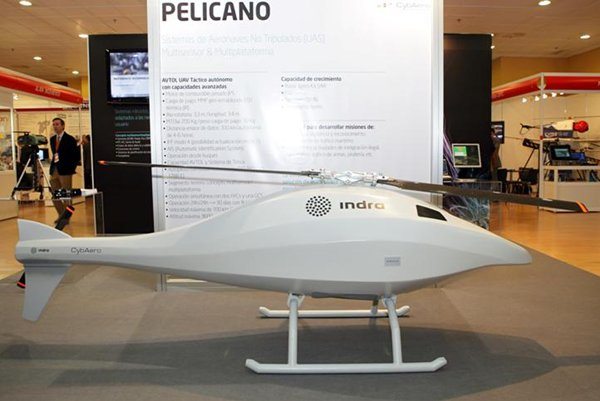Indra, with the support of the Ministry of Industry, Commerce and Tourism along with the Ministry of Defence, started up an R&D project to develop an Unmanned Aircraft System (UAS) of rotary wings and with dual use, either for civil or defence fields. The system will be launched in 2012 and will be one of the first worldwide to meet mission needs of any naval force.
The system can run for 24 hours a day for a month. It was initially conceived for surveillance, maritime traffic control, border control and support of rescue missions. However, once regulations allow manned and unmanned aircraft to coexist in air space, the Pelicano system will give support in emergency situations or will watch infrastructures, among other applications.
Regarding its potential uses for naval ships, its accurate and automatic vertical takeoff and landing capacity (AVTOL) and its medium size (3.3 meter rotor diameter and around 200 kg maximum take-off weight) make it the perfect solution for ships. It can also adapt to meet the needs of the Army and Security Corps.
The system consists of three or four helicopters and a fully interoperable control station which will receive the information collected in the air in real time. The solution is based on a tactical helicopter with a 100 km operational range and capable of flying at 3,600 meters high. For its development, Indra signed an agreement with the Swedish company Cybaero and will use the APID60 platform which is currently in use.
Based on the platform, Indra will build a complex mission system. The system will incorporate night-vision infrared electro-optical sensors, capable of capturing high-resolution images at great heights. The company will also supply a thorough terrain segment which will control the helicopter and will receive images in real time and a secure communication link with a suitable bandwidth.
Pelicano can be integrated with the vessels command system, becoming an extension of the embarked radars and sensors.
The mission system includes an IFF transponder, an identification component, and is also prepared to carry a light-weight radar, electronic intelligence systems and chemical, biological, radiological and nuclear (CBRN) threat detection sensors.
Leaders in UAV
The increasing needs of remote sensing functions during sustained operations, has boosted the use of unmanned aerial vehicles as the ideal platforms. Indra’s experience and knowledge in the electro-optical systems and radars contribute to Research and Development in the Unmanned Aerial Vehicle (UAVs) sector.
Indra has successfully led, along with EADS, the startup of the first tactical UAV system which the Spanish Army has used in a real scenario: PASI (Intelligence Autonomous Sensorised Platform) based on the Searcher Mk III UAV. The company has also developed a tactical system called Albhatros based on fixed-wing aircrafts and the Mantis mini UAVs.
Within the Atlante programme led by EADS for the development of a tactical long-range UAV, the company is in charge of the communications systems, electro-optical sensors, identification (IFF) and the image exploitation software.
In addition, Indra is engaged along with EADS and Thales in the design of the AURA radar which will be employed by strategic UAVs and in the development of the HORUS radar which will be embarked on helicopters and unmanned aerial vehicles.
Besides this, the Spanish company participates in the MIDCAS European project, which seeks to develop a Sense & Avoid system for UAVs to detect and avoid other aircraft in civil air space automatically. Finally in 2010 Indra was awarded a contract with the European Space Agency and in cooperation with the European Defence Agency to study the possibility of UAVs to coexist with civil aircraft in air space by using satellite communications systems.
Indra is the premier Information Technology company in Spain and a leading IT multinational in Europe and Latin America. It is ranked as the second European company in its sector according to stock market capitalisation, and also the second Spanish company with the most investment in R&D. In 2009, revenues reached € 2,513 M, of which a third came from the international market. The company employs more than 29,000 professionals and has clients in more than 100 countries.









